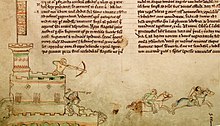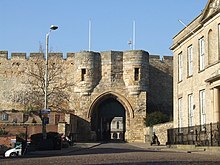Lincoln Castle
Lincoln Castle is a large castle that William the Conqueror built in Lincoln in the 11th century in place of a Roman fortress. It is unusual for the castle to consist of two moths . In addition to Lincoln Castle, only Lewes Castle in Sussex was built in this way. The castle served as a prison and courthouse until recently and is one of the better preserved castles in the country. The Crown Courts are still located there today. There is also a museum in the castle. Lincoln Castle is one of the most impressive Norman castles in the United Kingdom . Even today you can walk over the mighty Norman walls and enjoy a great view of the castle complex, the cathedral , the city and the surrounding country.
Medieval story
When William the Conqueror had defeated the English under the leadership of Harold Godwinson at the Battle of Hastings on October 14, 1066 , he still faced resistance to his rule from the north of England. For several years Wilhelm's position was very uncertain. In order to expand his influence northward and dominate the residents of the Danelag (an area that was anciently under the control of Scandinavian settlers), he built a series of castles in the central and north of England. It was then that the new king ordered the construction of Warwick Castle , Nottingham Castle and York Castle . After capturing York , William the Conqueror turned south where he came across the city of Lincoln, founded by the Romans and Vikings .
When Wilhelm Lincoln reached one of the larger settlements in the country, he found an economic and trading center for the Vikings with a population of 6,000 to 8,000. The remains of the old, fenced-in Roman fortress, about 60 meters above the land to the south and west, turned out to be a strategically ideal location for building a new castle. In addition, Lincoln was at the intersection of the following traffic routes, which had already determined the location of the Roman fort:
- Ermine Street - an important Roman road and north-south axis in the country connecting London to York.
- Fosse Way - another major Roman road connecting Lincoln to Leicester in south-west England.
- The river valley of the Trent (to the west and southwest) - a large river with access to the Ouse and thus to the great city of York.
- Des Witham - a waterway that has access to the Trent (via the Foss Dyke , a Roman canal near Torksey ) and the North Sea (via The Wash ).
- The Lincolnshire Wolds - a highland in northeast Lincoln above the Lincolnshire Marsh , a salt marsh.
A castle at this point could protect various strategically important routes and be part of a network of fortresses of the Norman Kingdom in Mercia , Denmark , roughly today's East Midlands . Also - and especially in the case of the Wolds - the castle was able to form a center for troops to repel Scandinavian attempts at conquest all along the coast from the Trent to the Welland . For the most part, they would have moved on the ancient Roman roads.
In the Domesday Book of 1086, 48 castles in England are specifically mentioned, two of them in Lincolnshire and one of them directly in Lincoln. Building a castle on a pre-existing settlement sometimes meant demolishing buildings that were in the way, and the Domesday Book states that 13 of the castles mentioned there did. In the case of Lincoln, 166 "uninhabited houses" were demolished to make way for the castle.
Work on the new fortress was completed in 1068. It is likely that a first wooden donjon was built first, which was later replaced by a stronger one made of stone. What is unusual is that Lincoln Castle has two moths; this can only be found at Lewes Castle. In the south of the new castle, the old Roman wall, which stands on a steep slope edge, was preserved partly as a curtain wall and partly as a cladding for the moths. In the west, where the terrain is flatter, the Roman wall disappeared into an earth wall and served as the foundation for the Norman castle wall. The western gate from Roman times, which was in the same place as the western gate of the Norman castle, was excavated in the 19th century, but began to collapse under the effects of the weather and was therefore buried again.
The First Battle of Lincoln , which took place on February 2, 1141 as part of the battle between King Stephen and Empress Matilda for the English throne, centered on the castle. The castle was held but damaged. Then a new tower was built, the Lucy Tower .

Lincoln Castle was besieged again on May 20, 1217 before the second Battle of Lincoln under the reign of Johann Ohneland during the First Barons' War . This was a period of political struggle that led to the signing of the Magna Carta on June 15, 1215. Then the east and west gates were fitted with new barbicanes .
More fortifications
There were other medieval fortifications in Lincoln that no longer exist today:
- A series of earth walls connected with one or the other siege were once where The Lawns are today to the west of the castle.
- Thorngate Castle was formerly on the river bank and formed the southeast corner of the city fortifications. There is evidence that it still existed in 1141, but was destroyed in 1151.
Modern history
As in Norwich and other places, Lincoln Castle was used as a safe place for a prison. The Lincoln prison was established in 1787 and expanded in 1847. Detained debtors were allowed some social contact, but criminals were held in solitary confinement. Therefore, the seats in the prison chapel were designed so that each prisoner could sit individually. The preacher could see each of the prisoners, but each of the prisoners could only see the preacher. This system was abandoned in 1878 and inmates were transferred to a new prison on the eastern outskirts of Lincoln. The castle prison rooms have remained unused since then until the Lincolnshire Archives were housed in the cells there .
William Marwood , the executioner of the 19th century, led by its first execution in Lincoln. In 1872 he used the long case that was supposed to break the delinquent's neck and not strangle him to execute Fred Horry . Until 1868 prisoners were publicly hanged on the wall tower on the northeast corner of the curtain wall, from which one can see the upper town.
today
The castle is now owned by Lincolnshire County Council and is listed as a Scheduled Monument . From 2012, the castle underwent a three-year renovation. A new exhibition center for the Magna Carta was built, as well as facilities for visitors, and some sections of the prison were opened to the public. The program was completed in April 2015 on the 800th anniversary of the signing of the Magna Carta. The Magna Carta in Lincoln Castle is one of four surviving copies, signed by Johann Ohneland after his meeting with the barons at Runnymede in 1215. An exhibition explains the origin of the document and its far-reaching significance.
Parts of the prison are open to the public as a museum, including the chapel from the 19th century, the only one in the world to have seats according to the “separate system” (each seat is individually locked). The women's wing of the prison was opened to visitors in 2005. Concerts and other public events are held on the castle grounds. In 2015 a gallery was opened on the outer castle wall.
Layout and architecture
Lincoln Castle is enclosed on three sides by a curtain wall. This curtain wall was erected before 1115, and it was immediately made of stone. On the south side this castle wall is interrupted by two earth walls, moths. One of them is located on the south-east corner and probably originally dates from the time of Wilhelm the Conqueror, the other can be found on the south-west corner. A tower with a square floor plan, the Observatory Tower , towers over the first-mentioned motte. It stands on the outer castle wall and dominates the city of Lincoln. The second-named moth is crowned by the Lucy Tower , believed to have been built in the 12th century and named after Lucy of Bolingbroke , the Countess of Chester until 1138.
The graves of those executed for various crimes are located on the castle grounds. They are equipped with simple tombstones on which only the initials of the convicts and the date of death are indicated. Fred Horry was buried in Lucy Tower along with many other criminals.
Also on the castle grounds are the remains of Lincoln's Eleanor Cross , a bay window brought here from Sutton Hall and inserted into the main gate, as well as the bust of King George III.
At the western end of the castle is an ivy-covered building that was built in 1826 as the Assize Courts . It still serves as Lincoln's Crown Courts today .
Individual evidence
- ↑ a b Lincoln Castle . Historic England Pastscape. Retrieved May 12, 2015.
- ↑ CG Harfield: A hand-list of Castles Recorded in the Domesday Book in English Historical Review . No. 106 (1991). Pp. 373, 380, 384.
- ↑ Jim Bradbury: The medieval archer . St. Martin's Press, New York 1985, ISBN 0-312-52665-2 , pp. 53 (English).
- ^ A b Tony Jaques: Dictionary of Battles and Sieges . Greenwood Publishing Group, 2007, ISBN 978-0-313-33538-9 , pp. 588 (English, google.co.uk [accessed May 12, 2015]).
- ↑ a b Monument no.326634 . Historic England Pastscape. Retrieved May 12, 2015.
- ^ Battle of Lincoln, 1217 . Historic England Pastscape. Retrieved May 12, 2015.
- ↑ Possible Site of Medieval Castle . Historic England Pastscape. Retrieved May 12, 2015.
- ^ Cory Santos: Searching for Lincoln's second castle . February 26, 2013. Retrieved May 12, 2015.
- ^ Sydney Painter: Review of Books in The Journal of Economic History . Book 9, Issue 2 (1949). Pp. 235-236. Work cited: JWF Hill: Medieval Lincoln . Cambridge University Press, Cambridge 1948. Retrieved May 12, 2015.
- ^ Thomas Allen: The history of the county of Lincoln . John Saunders, London and Lincoln 1833. p. 199. Retrieved May 12, 2015.
- ↑ Lincoln Castle Prison . Historic England Pastscape. Retrieved May 12, 2015.
- ↑ Lincoln Castle . Historic England List Entry. Retrieved May 12, 2015.
- ^ Lincoln Castle to get £ 19m improvement . In: BBC News . March 29, 2012. Retrieved May 12, 2015.
- ^ HM Colvin, R. Allen Brown, AJ Taylor: The history of the King's Works . Volume 2: The Middle Ages . Her Majesty's Stationary Office, London 1963. p. 704.
- ↑ Monument no.326269 . Historic England Pastscape. Retrieved May 12, 2015.
- ^ Lincoln Castle's History Discover Lincoln Castle's history . Retrieved May 12, 2015.
- ↑ Lincoln Castle. Archived from the original on March 24, 2016 ; Retrieved May 12, 2015 (Lincoln Castle website).
- ↑ Assize Courts . Historic England Pastscape. Retrieved May 12, 2015.
swell
- C. Knight: Penny Cyclopedia . The Society for the Diffusion of Useful Knowledge. 1839. p. 15.
- Richard Clarke Sewell: Gesta Stephani . Sumptibus Societatis, London 1846.
Web links
Coordinates: 53 ° 14 ′ 7 " N , 0 ° 32 ′ 27.4" W.






